Riding the Zero SR/F Pikes Peak Racer

Just how far can you push a production Zero?
The official line whenever I’ve spoken to Zero reps is that the company is in the business of making street bikes, not racers. But the hot rodding spirit is alive and burning when you look into the eyes of some of the people who work there, and so it only comes naturally that a core group of enthusiasts would take an SR/F and push its limits.
Having spent a little time with a stock SR/F, I’m familiar with the bike and how it behaves. Other than the instant torque, nothing about it really screams out “race me!” The seat’s cushy, the bars don’t tilt you forward too much, and the riding experience is just… pleasant (whether I want to shell out $20-large for one is another story, but I digress). Hopping onto the Pikes Peak SR/F, where I got to spin a few laps at the world-famous Weathertech Raceway Laguna Seca after World Superbike weekend, things felt… almost the same, actually. Just a little more focused. And before we go any further, if you’re not caught up on how the standard SR/F and Pikes Peak bike differ, click here to read about the conversion.
The feeling you get from the saddle as you call for a healthy dose of electrons is actually pretty similar to the standard bike – which in itself is still insanely quick. Not surprising considering the motor, controller, and battery are unchanged. You sit a little higher on the Pikes bike though, thanks to the custom subframe. The seat is also a little harder as a result, which is fine for a racebike, and the bars have a lower taper to them so Cory West, the man responsible for piloting the bike up Pikes Peak, could put more of his weight over the front.
Besides the custom bodywork and Dymag forged wheels, the big difference between stock and racer is the trick Showa BFF (Balance Free front Fork) gas-charged fork and BRFC-lite (Balance Free Rear Cushion-lite) shock the factory Kawasaki WSBK team uses. Since Showa provides Zero with suspension on the production bikes, every now and then Zero can call in a favor for the really good stuff. Even bumbling down the pits you can feel how taut the underpinnings are. Within three turns, the difference is even more apparent. Proper racing suspension communicates everything the motorcycle is doing underneath you in a way standard components simply can’t. Bumps you had never felt before on the stock stuff suddenly appear – not in a bad way, more like a consultant giving you all the information possible so you can make an informed decision about what to do next.
I didn’t go about making any changes to the bike, as West was primarily riding the bike that day and was nice enough to skip a couple sessions to let me have a go. Apart from the suspension, the left-hand rear brake lever took some getting used to. Trying to modulate both brakes with your hands in a performance setting is much different than doing it on a scooter, but West gave me some good advice: Use the front brake harder but the rear brake longer. This helped, especially if I needed to use the rear brake to tighten my line through a right-hand turn. From there the next biggest difference was the software settings. The air-cooled motor and controller of all Zeros can handle the rigors of street riding without much worry about heat. But in racing conditions the components reach their thermal limits quickly. The Pikes bike has revised firmware settings to allow the motor and controller to run deeper into its thermal limits before pulling back power.
That meant, according to West, I’d get two hot laps at Laguna before the SR/F’s temperature light started flashing. The surprising thing is how little power is dialed back once you hit the thermal limits. Previous Zeros I’d ridden would have slowed to a crawl to cool off. The Pikes bike trailed off maybe 20% or so. I was definitely slower, but I wasn’t a moving roadblock either. West advised I even pull off-line and coast around for half a lap, saying when he did so the components would cool off enough in that short amount of time to buy him another lap at full tilt. I didn’t take the advice, choosing instead to see if I could complete the 20-minute session or be forced to pit due to overheating. Surprisingly, I was able to stay out the whole session.
I fully admit riding around trying to manage heat is not the point of a trackday or a track-focused motorcycle. I’d go nuts if I had to ride like this every session, but as a one-time exercise, it was a fun challenge to manage the heat and ride at a decent pace. However, this bike wasn’t meant for trackdays. It was meant for Pikes Peak. There, West took the bike you see here to the summit in 10:46.233, making it the ninth-fastest motorcycle in the race, and second electric behind Robert Barber, piloting a dedicated electric racer built by the University of Nottingham (10:19.040).
When Zero decided to make an official entry into the 2019 Pikes Peak International Hill Climb with its all-new flagship SR/F, the skunkworks team of racers and engineers knew there was a big task ahead of them. Pikes Peak is a grueling test of man and machine, and considering the machine was an all-new model, there would be no frame of reference to look to. They were the frame of reference. But now that the bike is here, Pikes Peak is over, and won’t be back at least in 2020, and possibly for the foreseeable future, what happens now? That’s a big question mark. The team aren’t done developing it, and Cory would love to keep riding it. I would too.

Troy's been riding motorcycles and writing about them since 2006, getting his start at Rider Magazine. From there, he moved to Sport Rider Magazine before finally landing at Motorcycle.com in 2011. A lifelong gearhead who didn't fully immerse himself in motorcycles until his teenage years, Troy's interests have always been in technology, performance, and going fast. Naturally, racing was the perfect avenue to combine all three. Troy has been racing nearly as long as he's been riding and has competed at the AMA national level. He's also won multiple club races throughout the country, culminating in a Utah Sport Bike Association championship in 2011. He has been invited as a guest instructor for the Yamaha Champions Riding School, and when he's not out riding, he's either wrenching on bikes or watching MotoGP.
More by Troy Siahaan



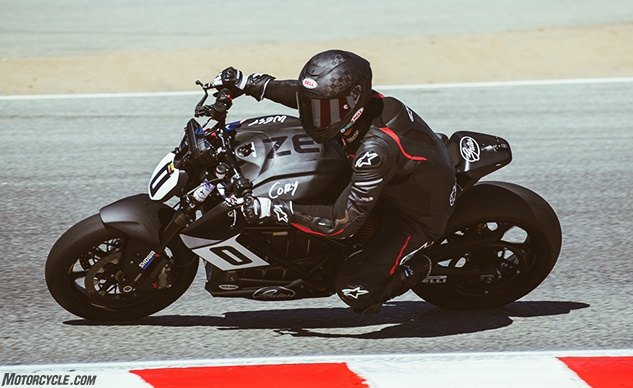

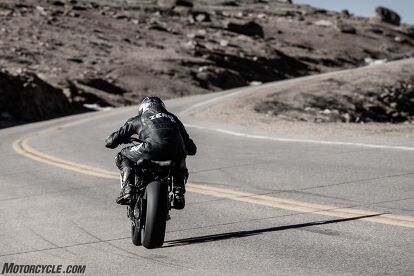























































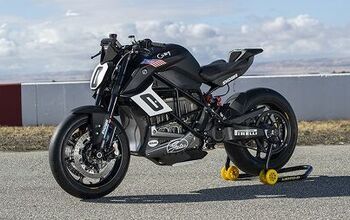








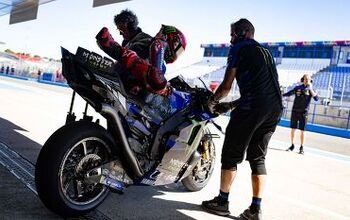





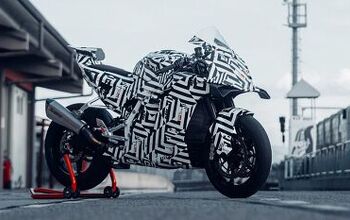
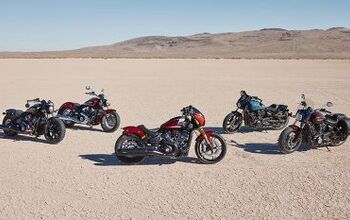

Comments
Join the conversation
Wait, you had this thing on the track?
What tire pressures did you use?!
LOL (at myself) Keep up the good work, Trizzle.
RideApart has a really interesting article on the SR/F. One of their writers took it on an 800-mile trip and wrote about the charging experience and the ride in general. At the moment they seem to equate to sail vs. power boats: if you're not in a rush, its a good choice. If getting there quickly is the goal, choose gas.
No more motorbikes at the Pikes Peak races.